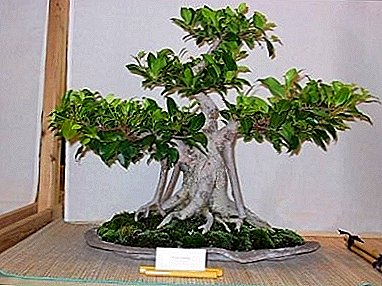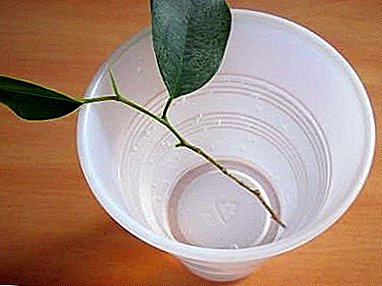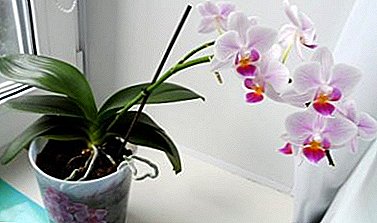
Many, seeing an orchid blooming in the store, want to buy it. But not everyone knows how to care for it, what kind of climate the plant loves, and what to do with a whole range of work before the phalaenopsis finally takes root in the apartment.
We will tell you about the nuances of choosing a healthy plant, about how to properly care for it immediately after purchase and what to do so that the plant is pleasing to the eye with its rapid flowering.
Differences in the content of the house and in the flower shop
 Conditions for keeping flowers in stores and at home after purchase are significantly different. The seller’s goal is to sell the plants, the sooner the better.
Conditions for keeping flowers in stores and at home after purchase are significantly different. The seller’s goal is to sell the plants, the sooner the better.
Flowers must be beautiful on the outside, without dried leaves.. Best of all, when phalaenopsis bloom, so the buyer will quickly pay attention to the plant.
To do this, the shops use some tricks:
- use dressing in an increased amount;
- abundant watering;
- sphagnum.
It comes to deception, when a dye is injected into the plant, and instead of white flowers appear bright blue, which does not exist in nature.
To see the condition of the roots of phalaenopsis, it must be purchased in a pot of transparent plastic.
Orchids in the store also have limited access to sunlight. Vendors use fitolampy. But the desired temperature and humidity in flower shops support. At home, ideal conditions need to be created, for which time is needed.
What is the adaptation period and how does it go?
Changing the shop microclimate to a flat for an orchid is of great importance. The flower reacts even to minor changes in humidity, temperature, lighting. It will take some time for the plant to adjust to the changes.. This is the period of adaptation.
During the adaptation buds and flowers fall off, the leaves become sluggish, turn yellow and dry. In fact, you should not be afraid. For orchids, this is the usual course of adaptation to a new climate.
In order for the plant to adapt more successfully, it must be supplied separately., create a "quarantine zone". It will also help avoid contamination of other home plants. In such a quarantine phalaenopsis should be kept for three weeks.
What should be done first and what should not be done?
Step-by-step instructions on what to do next if you bought an orchid in a store and brought it home:
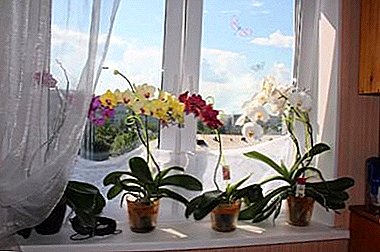 First thing Phalaenopsis should be examined for any insects and diseases. Having discovered the disease, do not start treatment immediately, but wait two weeks for the flower to adapt and grow stronger after the change of rooms.
First thing Phalaenopsis should be examined for any insects and diseases. Having discovered the disease, do not start treatment immediately, but wait two weeks for the flower to adapt and grow stronger after the change of rooms.- Inspect the bark poured into the pot. It should be without white bloom, which is poisonous to phalaenopsis. Bark with such a bloom should be removed and put back a new one.
- Check the pot for drain holes. They should be located not only on the bottom, but also on the sides of the pot. If the holes are missing, they must be made independently, the main thing in the process is not to damage the orchid's roots.
For the acquired phalaenopsis, it is necessary to allocate a place from which the flower cannot be removed later.
- You do not need to immediately plentifully water the land in a pot of an orchid bought from a store or feed it. Irrigation should be carried out no more than once a week, and the use of fertilizers and stimulants, for the time of the plant's adaptation, should be excluded altogether.
- No need to remove faded and yellow leaves. During adaptation, they can come to life or fall off from the plant themselves. Fading leaves give their energy to the plant, which he really needs.
We offer to watch a video on what else needs to be done after purchasing phalaenopsis:
Do I need to repot in another pot, and when is it necessary?
This question interests many gardeners. At all, while the plant is recovering after the move, it is not recommended to replant it. It is necessary to give him strength.
But in some cases, transplanting a room flower after buying in a store requires:
- soil decomposition occurred in the purchased pot and after irrigation it does not dry out for a long time (more than a week);
- phalaenopsis roots are affected, there are black spots on them or the root system has dried completely;
- leaves of the plant turn yellow, but not because of the natural process of dying.
The best time to purchase and transplant orchids is spring.
Step by step instructions: how to transplant?
Before landing it is necessary to prepare:
- Alcohol pre-cutter;
- soil;
- sphagnum moss;
- washed pot with soda;
- a small stick to push the soil between the roots;
- means to process cuts (brilliant green, crushed charcoal, cinnamon);
- expanded clay;
- drugs Epin and Fitosporin-M;
- cotton buds;
- sticks and clips for peduncles.
Actions:
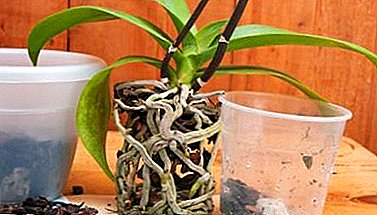 Prepare a plant-strengthening immunity solution to soak the orchid in it. To do this, 1/5 tsp. Fitosporina-M, diluted in a small amount of warm water. Add water to become two liters of solution. Add Epin (10 drops).
Prepare a plant-strengthening immunity solution to soak the orchid in it. To do this, 1/5 tsp. Fitosporina-M, diluted in a small amount of warm water. Add water to become two liters of solution. Add Epin (10 drops).- Take the orchid in the palm of the base and turn the pot upside down. If the root system does not exit, then the container needs to be cut.
- Clean the root system of the old soil. Phalaenopsis roots are fragile, you need to clean carefully.
- Inspect the flower. Damaged, dried leaves and roots must be trimmed. Healthy roots of an orchid should be elastic, clean, green or gray-green.
- Soak the root system of the flower for 40 minutes in a prepared solution of Fitosporin-M. Treat the trimmed roots with an antiseptic. Dry the roots for three to four hours.
- Set sticks for each peduncle plants.
- Cover the drainage tank at the bottom of the tank. Set the plant in the center. Cover the roots with soil. At first, it is better to bring in a little old, and then fill up with fresh substrate.
- Carefully score the empty space between the roots of the bark. To do this, you need to shake the pot a little. Upper roots can be left not covered. Put moss on top of the soil.
- Put the orchid in the allocated place for 10 days. The temperature should not exceed + 22 degrees. Watering the plant immediately after transplanting is not necessary.
- Phalaenopsis, like other flowers, can be placed on window sills or special supports. Most suitable windows on the east side.
- Orchids do not like direct sunlight. It can bloom well in the depths of the room, but the light day should be no less than 12 hours. If the windows are located on the south side, then in the summer you need to create an artificial shade for the plant. In the winter, with a short light day, fitolamps are used.
- The pot should be periodically turned so that the orchid does not fall on one side.
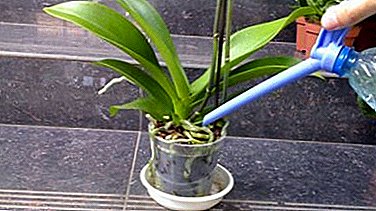 Before watering inspect the root system and soil.
Before watering inspect the root system and soil.- All moisture-absorbing substances (moss) must be removed from the substrate.
- The plant is dried, the root system is painted in silver. Such a plant needs watering.
- Dry potted soil, bark badly moistened. This may be due to a violation of the method of manufacturing the substrate. It is necessary to change the soil.
- Black and soft roots phalaenopsis. Indicate a regular overflow of soil. The bark does not dry out, the roots do not have enough oxygen and they begin to die. Need to transplant a plant.
- Often in the substrate and on the shop orchids themselves insect pests are present. They can affect not only the outer part of the plant, but also its root system. In this case, the plant is treated with the necessary preparations.
We offer to watch a video about phalaenopsis transplantation:
How to care for a houseplant bought in a store?
After the plant is purchased and brought home, it is not enough to put it in any place. The orchid needs proper care. and creating a familiar microclimate for her.
We offer to watch the video about the care of the purchased phalaenopsis:
Choosing a place
Creating conditions for growing
 Phalaenopsis need moist air. In the apartment, especially in winter, the air is very dry. Therefore it is necessary to use humidifiers. They can be purchased or homemade. Perfectly suited pan with water, in which you need to fill the clay or pebbles. On the stones set the pot with a flower.
Phalaenopsis need moist air. In the apartment, especially in winter, the air is very dry. Therefore it is necessary to use humidifiers. They can be purchased or homemade. Perfectly suited pan with water, in which you need to fill the clay or pebbles. On the stones set the pot with a flower.
Orchid, in a small amount and only before lunch, you can spray. It is important to ensure that water does not remain in the leaf axils, otherwise the flower will rot. In the hot season, next to the orchid you need to put a container filled with water.
The room must be periodically ventilated, but that the plant itself is not in a draft. The best temperature range for an orchid is from + 24 to + 29 degrees in summer and from + 17 to + 25 degrees in winter. Phalaenopsis has no pronounced rest period. To stimulate the formation of buds, it is necessary to lower the temperature to + 17. Keep the plant in it for 2-2.5 weeks, before the formation of buds.
Temporary (1-3 days) lowering the temperature to + 11 or + 15 degrees is not fatal for an orchid, but it is better to make sure that this does not happen. If the cold drags on, the plant becomes sick or dies completely.
Inspecting the plant and determining its needs
It happens that the actions are performed correctly, and the orchid has ceased to grow and weakened. This can be associated with abundant watering in the store. Withering and drying leaves are not always a sign of lack of moisture..
If phalaenopsis is over dried, then it can be restored after the first watering. But if it is flooded, then it will be difficult to save the plant. When overflowing, it is necessary to urgently stop watering and repot the orchid.
If there is a scarlet or a spider mite on the plant, it must be treated with an agent intended against one or another type of pest.
First watering
After purchase, the plant is not watered., and let him go through the process of adaptation.
For irrigation, the water must be clean, passed through the filterwarm. Watering is better in the morning to let the plant dry up in the evening. A good way to water when the pot with Phalaenopsis is put for 2-3 hours in a bowl filled with water. The bark and roots absorb the necessary water rate for the plant.
Phalaenopsis like moderate watering. They can tolerate short periods of dryness. But acutely react to watering without a regime. To make up the irrigation mode, you need to take into account the temperature and humidity in the room, what time of year, and the condition of the plant.
Next steps
Usually the orchid brought from the store has already picked up a color or is about to bloom. During flowering, phalaenopsis should be protected from bright light. and produce watering once every 3-4 days.
After the plant has faded, the arrow is cut. The pot is exposed to light, irrigation is reduced. Orchid fertilizer is held in spring.
Possible problems
 Due to the change in conditions, the shop orchid may experience the following problems:
Due to the change in conditions, the shop orchid may experience the following problems:
Phalaenopsis is the best gift for flower growers, but it is whimsical in its own way and with its own characteristics. If you learn the rules of orchid care, you can collect many plant species at home, including rare specimens. And then admire how they bloom magnificently.


 First thing Phalaenopsis should be examined for any insects and diseases. Having discovered the disease, do not start treatment immediately, but wait two weeks for the flower to adapt and grow stronger after the change of rooms.
First thing Phalaenopsis should be examined for any insects and diseases. Having discovered the disease, do not start treatment immediately, but wait two weeks for the flower to adapt and grow stronger after the change of rooms. Prepare a plant-strengthening immunity solution to soak the orchid in it. To do this, 1/5 tsp. Fitosporina-M, diluted in a small amount of warm water. Add water to become two liters of solution. Add Epin (10 drops).
Prepare a plant-strengthening immunity solution to soak the orchid in it. To do this, 1/5 tsp. Fitosporina-M, diluted in a small amount of warm water. Add water to become two liters of solution. Add Epin (10 drops). Before watering inspect the root system and soil.
Before watering inspect the root system and soil.
